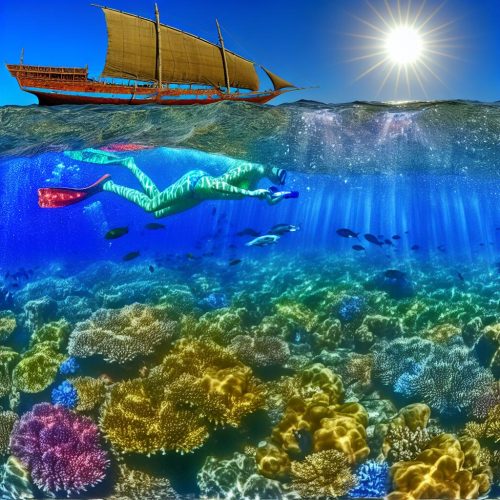Introduction to Snorkeling in the Indian Ocean
Snorkeling in the Indian Ocean is a unique and captivating experience, offering an unparalleled opportunity to explore diverse marine ecosystems. The ocean, bordered by several countries, provides a wide range of snorkeling spots, each with its own unique features. This article will cover some critical aspects of snorkeling in this region, including popular destinations, biodiversity, and conservation efforts.
Popular Snorkeling Destinations
The Indian Ocean is home to several renowned snorkeling spots, attracting enthusiasts from around the globe. Each destination offers unique marine landscapes, biodiversity, and cultural experiences.
Maldives
Known for its stunning coral reefs and crystal-clear waters, the Maldives offers some of the best snorkeling experiences in the world. The waters around the atolls are teeming with a variety of marine life, including turtles, sharks, and colorful fish. The Maldives’ atolls provide calm, warm waters perfect for snorkeling, making it a preferred destination for both beginners and experienced snorkelers. Small boat tours are available and often expand to uninhabited islands, where the undisturbed marine environment provides unique snorkeling encounters. For more details on planning your trip, visit the official tourism site.
Seychelles
The Seychelles archipelago boasts numerous snorkeling opportunities with vibrant coral reefs and rich biodiversity. Local marine parks, such as Sainte Anne Marine National Park, are ideal for snorkeling activities. The surrounding waters are warm and relatively shallow, making it easy to dive in and explore. Sea turtles and myriad tropical fish species can frequently be seen swimming in clusters around the colorful reefs. It’s advisable to contact local guides who provide snorkeling tours that often include stops at the best snorkeling sites. Additional information can be found at the Seychelles Tourism.
Andaman and Nicobar Islands
Part of India, the Andaman and Nicobar Islands offer pristine waters and untouched marine biodiversity, perfect for snorkeling enthusiasts. Havelock Island, with its lush, crystal-clear blue waters and vibrant coral reefs, is particularly popular for its underwater marvels. Other locations like Neil Island provide serene beaches and less crowded snorkeling spots for intimate marine adventures. The islands are known for their biodiversity, including species of clownfish, manta rays, and vibrant clusters of coral. To plan your journey, visit Andaman Tourism.
Marine Biodiversity
The Indian Ocean’s waters host over 2,000 species of fish, alongside various forms of coral and marine plants. This rich biodiversity is forged by the unique intersection of ocean currents and stable water temperatures. These factors provide a nurturing environment conducive to thriving ecosystems. Notable species include the Whale Shark, which is the largest known fish species, and can often be seen cruising near the coral reefs. Manta Rays, with their majestic wingspans, are prevalent around the Southeast African coast and other shallow waters. Various types of Sea Turtles, including the Green Turtle and Loggerhead Turtle, can be seen along many snorkeling routes, contributing to the ocean’s diverse aquatic tapestry.
Conservation and Sustainability
Conservation efforts in the Indian Ocean are crucial to maintaining its rich marine biodiversity. Many countries adjacent to the Indian Ocean have taken substantial steps to protect their marine environments and promote sustainable tourism. Marine reserves and national parks have been established as safe havens for marine life, offering them the protection needed to thrive. Organizations dedicated to conservation are also addressing critical issues like coral bleaching, which threatens to disrupt these ecosystems, by developing restoration programs. Efforts to combat marine pollution are also being ramped up, focusing on reducing plastic waste and encouraging eco-friendly initiatives. These measures strive to ensure that the Indian Ocean’s vibrant marine ecosystems are preserved for future generations.
Conclusion
Snorkeling in the Indian Ocean offers an incredible chance to witness vibrant marine life and explore pristine underwater landscapes. The variety of destinations and the rich biodiversity create countless opportunities for adventure and exploration. However, it is essential to respect and preserve this natural beauty by prioritizing conservation efforts and participating in sustainable tourism practices. By doing so, snorkelers contribute to the health of these ecosystems and aid in the preservation of one of our planet’s most enchanting natural wonders.
